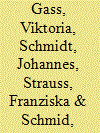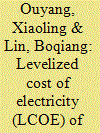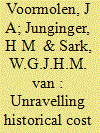|
|
|
Sort Order |
|
|
|
Items / Page
|
|
|
|
|
|
|
| Srl | Item |
| 1 |
ID:
117331


|
|
|
|
|
| Publication |
2013.
|
| Summary/Abstract |
In the European Union, electricity production from wind energy is projected to increase by approximately 16% until 2020. The Austrian energy plan aims at increasing the currently installed wind power capacity from approximately 1 GW to 3 GW until 2020 including an additional capacity of 700 MW until 2015. The aim of this analysis is to assess economically viable wind turbine sites under current feed-in tariffs considering constraints imposed by infrastructure, the natural environment and ecological preservation zones in Austria. We analyze whether the policy target of installing an additional wind power capacity of 700 MW until 2015 is attainable under current legislation and developed a GIS based decision system for wind turbine site selection.Results show that the current feed-in tariff of 9.7 ct kW h-1 may trigger an additional installation of 3544 MW. The current feed-in tariff can therefore be considered too high as wind power deployment would exceed the target by far. Our results indicate that the targets may be attained more cost-effectively by applying a lower feed-in tariff of 9.1 ct kW h-1. Thus, windfall profits at favorable sites and deadweight losses of policy intervention can be minimized while still guaranteeing the deployment of additional wind power capacities.
|
|
|
|
|
|
|
|
|
|
|
|
|
|
|
|
| 2 |
ID:
111340


|
|
|
|
|
| Publication |
2012.
|
| Summary/Abstract |
Based on recent research showing that hydrogen enrichment can lower NOx emissions from landfill gas combustion below future NOx emission control standards imposed by both federal and California state regulations, an investigation was performed to compare the levelized cost of electricity of this technology with other options. In this cost study, a lean-burn reciprocating engine with no after-treatment was the baseline case to compare six other landfill gas-to-energy projects. These cases include a lean burn engine with selective catalytic reduction after treatment, a lean-burn microturbine, and four variations on an ultra-lean-burn engine utilizing hydrogen enrichment with each case using a different method of hydrogen production. Only hydrogen enrichment with an in-stream autothermal fuel reformer was shown to be potentially cost-competitive with current strategies for reaching the NOx reduction target in IC engines.
|
|
|
|
|
|
|
|
|
|
|
|
|
|
|
|
| 3 |
ID:
180167


|
|
|
|
|
| Summary/Abstract |
This work analyzes the grid parity of distributed photovoltaic generation (DG-PV) in the province of San Juan-Argentina, proving that currently, the levelized cost of DG-PV is on average 20% higher than the tariff price for residential customers. In order to achieve the grid parity, the provincial government should implement incentive mechanisms such as the Net Billing proposed in the National Law 27.424 (2017). The impact of the Net Billing scheme proposed in such law, from the point of view of a typical residential user, and also compared with the impact of the Net Metering and Feed-in Tariff mechanisms are presented in this work. Results show that the Net Metering scheme could be the most profitable or economically beneficial for PV-owners, but it could have some negative impact on the incomes of utilities. Besides, investment decisions in renewable distributed generation are significantly affected by technological costs, national financial conditions, and tariffs. This analysis also suggests that taxes included in the tariff structure are an important aspect to take into account for implementing incentive mechanisms. Finally, some energy policies are recommended to guarantee the profitability of DG-PV systems and to assist the government in making decisions to promote these systems.
|
|
|
|
|
|
|
|
|
|
|
|
|
|
|
|
| 4 |
ID:
132748


|
|
|
|
|
| Publication |
2014.
|
| Summary/Abstract |
The development and utilization of renewable energy (RE), a strategic choice for energy structural adjustment, is an important measure of carbon emissions reduction in China. High cost is a main restriction element for large-scale development of RE, and accurate cost estimation of renewable power generation is urgently necessary. This is the first systemic study on the levelized cost of electricity (LCOE) of RE in China. Results indicate that feed-in-tariff (FIT) of RE should be improved and dynamically adjusted based on the LCOE to provide a better support of the development of RE. The current FIT in China can only cover the LCOE of wind (onshore) and solar photovoltaic energy (PV) at a discount rate of 5%. Subsidies to renewables-based electricity generation, except biomass energy, still need to be increased at higher discount rates. Main conclusions are drawn as follows: (1) Government policy should focus on solving the financing problem of RE projects because fixed capital investment exerts considerable influence over the LCOE; and (2) the problem of high cost could be solved by providing subsidies in the short term and more importantly, by reforming electricity price in the mid-and long-term to make the RE competitive.
|
|
|
|
|
|
|
|
|
|
|
|
|
|
|
|
| 5 |
ID:
119790


|
|
|
|
|
| Publication |
2013.
|
| Summary/Abstract |
New solar Photovoltaic (PV) installations have grown globally at a rapid pace in recent years. We provide a comprehensive assessment of the cost competitiveness of this electric power source. Based on data available for the second half of 2011, we conclude that utility-scale PV installations are not yet cost competitive with fossil fuel power plants. In contrast, commercial-scale installations have already attained cost parity in the sense that the generating cost of power from solar PV is comparable to the retail electricity prices that commercial users pay, at least in certain parts of the U.S. This conclusion is shown to depend crucially on both the current federal tax subsidies for solar power and an ideal geographic location for the solar installation. Projecting recent industry trends into the future, we estimate that utility-scale solar PV facilities are on track to become cost competitive by the end of this decade. Furthermore, commercial-scale installations could reach "grid parity" in about ten years, if the current federal tax incentives for solar power were to expire at that point.
|
|
|
|
|
|
|
|
|
|
|
|
|
|
|
|
| 6 |
ID:
150401


|
|
|
|
|
| Summary/Abstract |
This paper aims to provide insights in the cost developments of offshore wind energy in Europe. This is done by analysing 46 operational offshore wind farms commissioned after 2000. An increase of the Capital Expenditures (CAPEX) is found that is linked to the distance to shore and depth of more recent wind farms and commodity prices. Analysis results indicate that these two factors are only responsible for about half of the observed CAPEX increase, suggesting other factors such as turbine market with limited competition also led to an increasing CAPEX. Using CAPEX, Annual Energy Production, Financings costs and Operational Expenditures, the development of average Levelized Cost of Electricity (LCoE) is shown to increase from 120 €/MWh in 2000 towards 190 €/MWh in 2014, which is a direct result of the CAPEX increase. The results indicate very different LCoE values among European countries, from currently about 100 Euro/MWh in Denmark and Sweden to 150-220 Euro/MWh in all other countries investigated suggesting an effect of national policy frameworks on the LCoE of offshore wind energy.
|
|
|
|
|
|
|
|
|
|
|
|
|
|
|
|
|
|
|
|
|